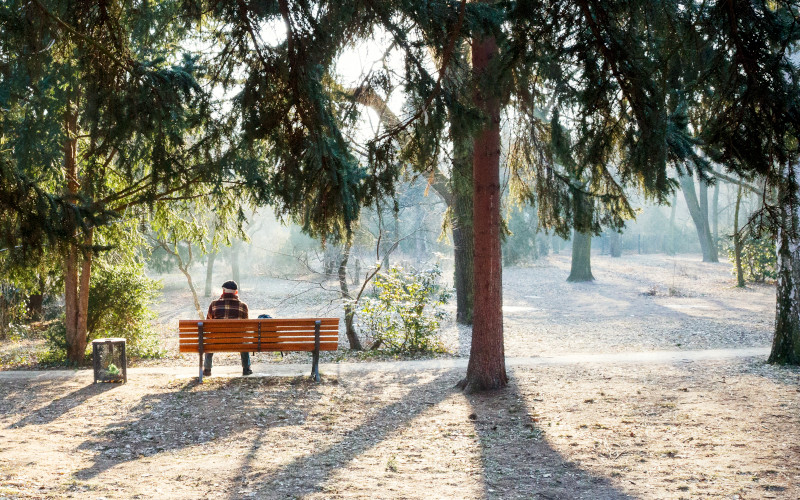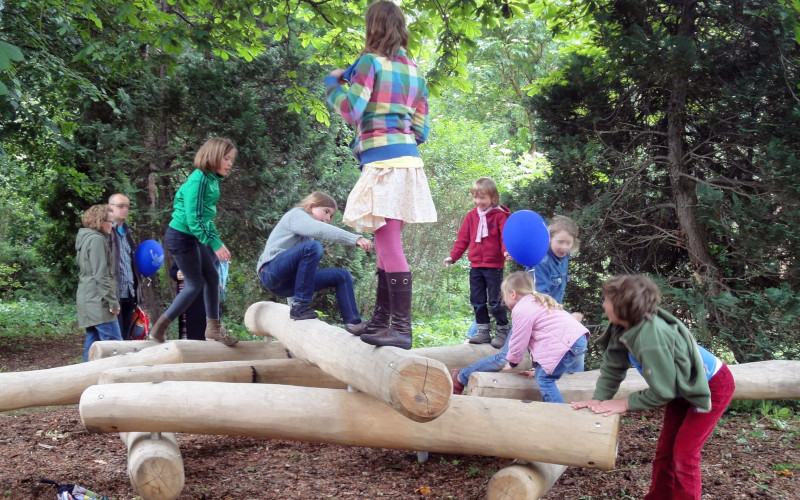Design between biodiversity and climate adaptation
By Gabriele Pütz
Events such as heatwaves or heavy rainfall are no longer extreme events in today's climate, "as they are no longer extremely rare" (Friederike Otto 2017). We are called upon not only to add another chapter to the "cultural history of climate" (Wolfgang Behringer 2019), but also to counter the threat to our livelihoods by changing direction.
How can landscape architecture shape this change of direction, create and preserve open spaces under the restrictive conditions of climate change and the biodiversity crisis? How do we formulate images of the future that are stronger than the fear-based avoidance of dangers through prohibitions in the present?
Landscape architecture of the Anthropocene will not succeed simply by recognizing the necessary restrictions. Rather, it requires effective stimuli: an aesthetically conveyed openness and curiosity about change.
Intrinsic motivation is required in order to actively participate in the transformation of our society and thus in the changing appearance of our nature with regard to the challenges of biodiversity, climate protection and climate adaptation.
Nature as a product, process and image
The shape of concrete nature is almost everywhere the result of human appropriation processes, the product of work, both in agrarian societies and in industrial society.
At the same time, nature is seen as an image, as a product of aesthetic perception. Nature as a viewed image, as an aesthetically conveyed image, offers room for emotions and associations through a judgment of taste. The image creates space for interpretation and new perspectives. In the "free play of imagination and reason" (Immanuel Kant 1974), in aesthetic judgment, creative processes are stimulated and released. An "understanding" of the concrete object of contemplation, the place, becomes possible.
The appropriation (nature as a product) and the aesthetic perception of nature (nature as an image) are in a reciprocal relationship with each other. What is perceived as beautiful nature is not a constant, but has changed again and again in the course of history. Beautiful nature is therefore not an absolute category independent of man, but the product of human perception. What is seen as beautiful nature in each case is directly related to the respective social conditions and thus also to the socially determined appropriation processes of nature.
If the real and expected image of nature and landscape correlate, the latter is generally perceived as beautiful. If the two diverge, the perception of beauty has to be struggled for by means of aesthetic education and creative-artistic mediation. (cf. Gabriele Pütz 2002)
Do we have the right images for today's cultural transformation, for the landscapes of the Anthropocene?
What images of nature, parks, gardens and landscapes can we use to try to understand our culture in the transition to the post-fossil energy age? Conveying the necessary transformation primarily through bans, renunciations and restrictions on our living environment is neither desirable nor would this approach gain social acceptance or release any intrinsic motivation. This can be seen very clearly in the current political debates. Nature-based and technological climate adaptation measures are only convincing if they are aesthetically conveyed as a variety of new possibilities, cultural enrichment and economic perspectives.

The floodplain, which was not rebuilt after the flood, can be such an answer if it is also aesthetically perceived as beautiful in the sense of preserving natural beauty and biodiversity. However, technical structures such as wind turbines are also part of our post-fossil cultural landscape. Their acceptance must also be conveyed through aesthetic considerations.
It is particularly important for landscape architecture not only to look at selective effects, but also to draw attention to the influencing causes and complex interrelationships. And this is where the degree of sealing, the storage capacity of our open spaces and the plant diversity in the designed spaces become multiple answers to polycrises: Shade provider, water reservoir and liveable functional space, more beautiful than ever!
The aesthetic judgment
The aesthetic judgment says something about whether we perceive something as beautiful or not. Beauty is not a measurable proposition, but lies in the eye of the beholder, based on reason (rationality) and understanding (cultural imprint, morality).
If I do not view the created, e.g. the open space, solely through the lens of reason, but allow a scenery to have an effect on me without purpose in the free play of the power of integration and I trigger associations in the process, I perceive this as beautiful. So I judge something as beautiful if I can connect what I see with my values, my knowledge and my cultural background, i.e. if it is connectable for me and at the same time opens up new contexts.
How can I, as a planner/designer, make such aesthetic judgments possible?
The aim is to stimulate the imagination. One possibility is to use narratives to tell stories with the open space. By developing open spaces together with the users, working out the wishes and desires of the users and at the same time conveying ecological requirements, regional or neighborhood identities are perpetuated. This creates a connection to the space and thus a sense of responsibility.
However, the culturally connecting elements are often missing, partly because many people are not aware of the connections between cycles, biodiversity and coexistence and are therefore unable to associate them. How can landscape architects respond to this? For example, we can offer experiences of nature through walks as part of participatory processes.
Aesthetic judgment is a cultural achievement and emerged with the Enlightenment. Connections are created through associative links between what I see and what I know, what I know and what I consider to be right or wrong. These values are based on cultural and social imprints. In the free play of the imagination, aesthetic judgment creates a common cultural, moral and rational background. The exchange of associations in aesthetic observation facilitates understanding by means of individually created links and insights and promotes a sense of community.

The aesthetic judgment is not an objective judgment, but it is not arbitrary either. It is intersubjective. People can agree on whether they judge something to be beautiful. And they can discuss why they judge it to be beautiful by sharing their associations and the newly recognized connections that looking at the object triggers in them and discussing them with others. This makes it possible to argue about beauty. This debate in a productive sense allows us to exchange ideas about what the contemplation of a garden, a landscape or a wind farm - in reality or in design - triggers in us and what associations we associate with it.
In this way, the discussion about beauty can provide a common vocabulary for discussing differences in beliefs, values and value orientations. In participatory processes, this can contribute to a mutual understanding between groups with different backgrounds.
But how must a space, a cultural landscape, be designed so that it is perceived as beautiful? This question arises above all for newly emerging spaces that offer solutions for current social requirements of climate adaptation or biodiversity, such as open spaces built according to the principle of the sponge city. This is because these do not correspond to the traditional park and landscape images that have been handed down for centuries. One example is the changed perception of fallow land, which is often not perceived as beautiful at first glance. However, the narrative of wilderness is then used to convey an aesthetic message. The unfamiliar view of the beauty of fallow land can be trained using design elements. Such accentuations open up scope for creativity and imagination. The design intervention encourages people to look at the site from a new perspective and to find beauty in what is already there. No extensive conversion of the urban nature areas is necessary to implement this approach. What is already there is merely aesthetically enhanced by individual design accents, contrasts become visible and new images point to the interrelationships of dynamic landscape spaces.
Functional art
Aesthetic judgment is a cultural achievement that arises in interaction between the culturally and socially influenced subject and the object being viewed. Even the "disinterested pleasure" referred to by Kant is not unconditional. Nevertheless, the empfilling of beauty (disinterested pleasure) differs from the empfilling of the pleasant (pleasing to the senses) and the good (moral judgment). In a convincing open space design, the pleasant and the good should be pursued together with the beautiful. Beauty thus addresses the mediation level of ideas, the intersubjective agreement. And thus creates a sense of community.
Landscape architecture is therefore a functional art (microclimate, water conservation, biodiversity, etc.) as well as an enabler of pleasant sensations, a stimulation of the senses. And landscape architecture aspires to achieve beauty, to achieve a sense of well-being in aesthetic judgment.

Landscape architecture's contribution to aesthetic education is important for this. The images in the mind that are traditionally perceived as beautiful are a consequence of what is conveyed as beautiful through education, what has been experienced as beautiful so far and what corresponds to one's own and socially conveyed values.
As the socially desirable changes, so do these images and judgments. The landscape as designed nature offers cultural linking elements that need to be strengthened due to the alienation from nature (little concrete experience of nature, living in virtual worlds or in neighborhoods far removed from nature) in order to create associations and links in the free play of the imagination. Promoting concrete experiences of natural diversity in society, for example through the sustainable design of nursery and school open spaces, can be achieved by making biodiverse environments a direct place of learning and experience, where I can experience wilderness, plants, animals, rain, sun and mud on a daily basis.
Nature is a cultural idea.
What we see as beautiful nature has changed again and again over the course of history and corresponds to our idea of living becoming and passing away. "Landscape is nature that is aesthetically present to a feeling and feeling observer." (Ritter 1963, p. 150)
We become aware of the dynamics of nature by creating images of change, by aesthetically conveying contrasts between preservation, cyclical return and dynamic development as beauty.
Bibliography
- Arjen E. Buijs, 2009: Lay People's Images of Nature: Comprehensive Frameworks of Values, Beliefs, and Value Orientations, Society and Natural Resources, online 417-432, DOI: 10.1080/08941920801901335
- Behringer W. 2019: Kulturgeschichte des Klimas - Von der Eiszeit bis zur globalen Erwärmung, Munich.
- Kant I. 1974: Critique of Judgment, Frankfurt/Main
- Kornhardt K., Pütz G., Schröder T. eds. 2002: Possible Spaces - City Creates Landscape, Hamburg 2002.
- Otto F. 2019: Wütendes Wetter -Auf der Suche nach den Schuldigen für Hitzewellen, Hochwasser und Stürme, Berlin.
- Otto F. 2017: Attribution of weather and climate events. In: Annual Review of Environment and Resources 42, 2017,627-646.
- Pütz G. 2002: Schönheit Sinn ohne Verstand - Zur Bedeutung des Ästhetischen in der Landschaftsarchitektur, Freising.
- Pütz G. 2002: Inszenierung der Landschaft - Chancen und Gefahren, pp. 43-55, in: Berliner Debatte Initial 13 (2002) 4, Berlin
- Pütz G. 2007: Lusatia as a logo? Landscapes between exploitation, appropriation and enlightenment. In: Ulrich Eisel, Stefan Körner (eds.) Landschaft in einer Kultur der Nachhaltigkeit, Vol. II Landschaftsgestaltung im Spannungsfeld zwischen Ästhetik und Nutzen, Kassel 2007.
- Ritter J. 1963: The task of the humanities in modern society. In Ritter J. 1974: Metaphysics and Politics. Studies on Aristotle and Hegel, Frankfurt/Main.
Author: Gabriele Pütz, landscape architect bdla, gruppe F Freiraum für alle GmbH, Berlin. The text was published in the bdla association magazine "Landschaftsarchitekt:innen" 1/2024.
- Latitude: 0
- Longitude: 0


